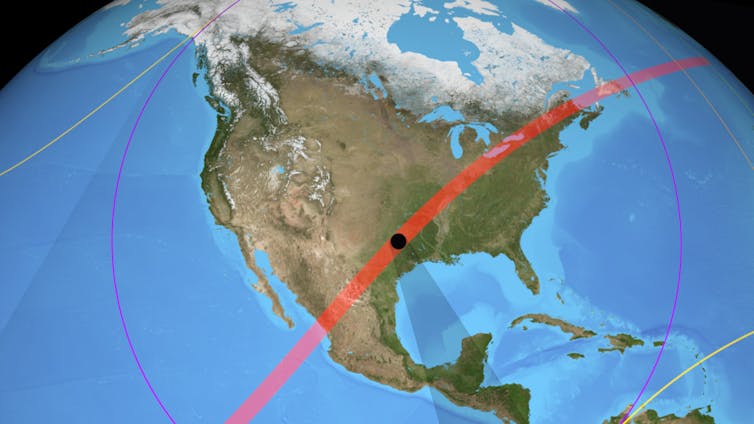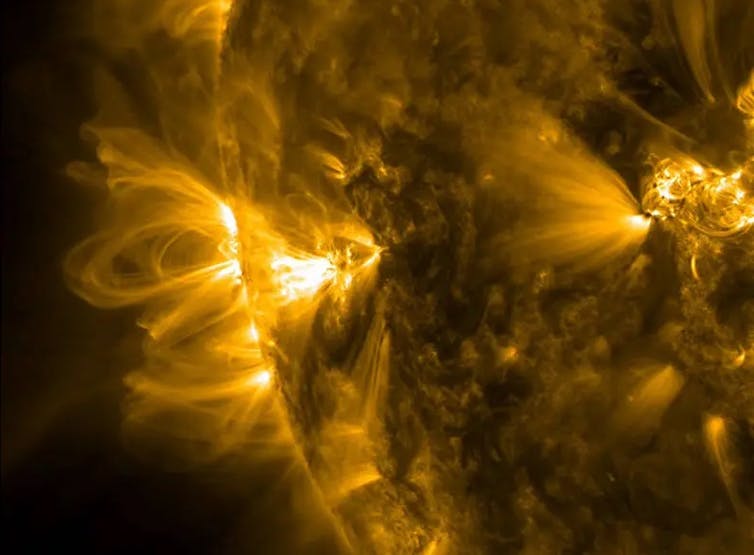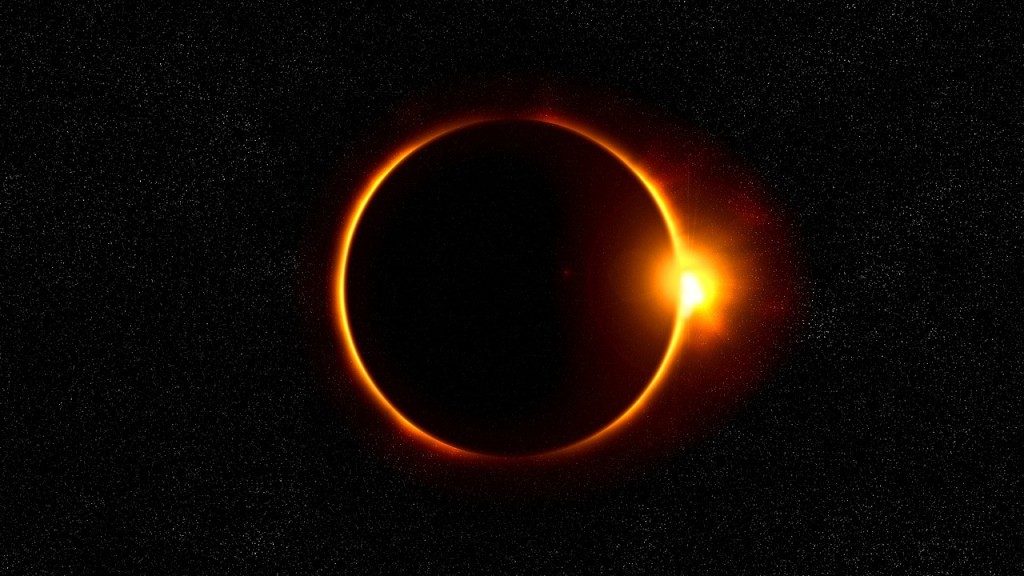Total Solar Eclipse On April 8 May Finally Solve Scientific Mystery
A total solar eclipse takes place on April 8 across North America. These events occur when the Moon passes between the Sun and Earth, completely blocking the Sun’s face. This plunges observers into a darkness similar to dawn or dusk.
During the upcoming eclipse, the path of totality, where observers experience the darkest part of the Moon’s shadow (the umbra), crosses Mexico, arcing northeast through Texas, the Midwest, and briefly entering Canada before ending in Maine.
Total solar eclipses occur roughly every 18 months at some location on Earth. The last total solar eclipse that crossed the US took place on August 21, 2017.
An international team of scientists, led by Aberystwyth University, will be conducting experiments from near Dallas at a location in the path of totality. The team consists of PhD students and researchers from Aberystwyth University, NASA Goddard Space Flight Center in Maryland, and Caltech (California Institute of Technology) in Pasadena.
There is valuable science to be done during eclipses that are comparable to or better than what we can achieve via space-based missions. Our experiments may also shed light on a longstanding puzzle about the outermost part of the Sun’s atmosphere – its corona.
Natural Blaze is Google-Free — We Need Your Support
Contribute Just $1 Per Month at Patreon to Aid the Cause of Health Freedom

The Sun’s intense light is blocked by the Moon during a total solar eclipse. This means that we can observe the Sun’s faint corona with incredible clarity from distances very close to the Sun, out to several solar radii. One radius is the distance equivalent to half the Sun’s diameter, about 696,000km (432,000 miles).
Measuring the corona is extremely difficult without an eclipse. It requires a special telescope called a coronagraph that is designed to block out direct light from the Sun. This allows fainter light from the corona to be resolved. The clarity of eclipse measurements surpasses even coronagraphs based in space.
We can also observe the corona on a relatively small budget, compared to, for example, spacecraft missions. A persistent puzzle about the corona is the observation that it is much hotter than the photosphere (the visible surface of the Sun). As we move away from a hot object, the surrounding temperature should decrease, not increase. How the corona is heated to such high temperatures is one question we will investigate.
We have two main scientific instruments. The first of these is Cip (coronal imaging polarimeter). Cip is also the Welsh word for “glance”, or “quick look”. The instrument takes images of the Sun’s corona with a polarizer.
The light we want to measure from the corona is highly polarized, which means it is made up of waves that vibrate in a single geometric plane. A polarizer is a filter that lets light with a particular polarization pass through it while blocking light with other polarizations.
The Cip images will allow us to measure fundamental properties of the corona, such as its density. It will also shed light on phenomena such as the solar wind. This is a stream of sub-atomic particles in the form of plasma – superheated matter – flowing continuously outward from the Sun. Cip could help us identify sources in the Sun’s atmosphere for certain solar wind streams.
Direct measurements of the magnetic field in the Sun’s atmosphere are difficult. But the eclipse data should allow us to study its fine-scale structure and trace the field’s direction. We’ll be able to see how far magnetic structures called large “closed” magnetic loops extend from the Sun. This, in turn, will give us information about large-scale magnetic conditions in the corona.

The second instrument is Chils (coronal high-resolution line spectrometer). It collects high-resolution spectra, where light is separated into its component colors. Here, we are looking for a particular spectral signature of iron emitted from the corona.
It comprises three spectral lines, where light is emitted or absorbed in a narrow frequency range. These are each generated at a different range of temperatures (in the millions of degrees), so their relative brightness tells us about the coronal temperature in different regions.
Mapping the corona’s temperature informs advanced, computer-based models of its behavior. These models must include mechanisms for how the coronal plasma is heated to such high temperatures. Such mechanisms might include the conversion of magnetic waves to thermal plasma energy, for example. If we show that some regions are hotter than others, this can be replicated in models.
This year’s eclipse also occurs during a time of heightened solar activity, so we could observe a coronal mass ejection (CME). These are huge clouds of magnetized plasma that are ejected from the Sun’s atmosphere into space. They can affect infrastructure near Earth, causing problems for vital satellites.
Many aspects of CMEs are poorly understood, including their early evolution near the Sun. Spectral information on CMEs will allow us to gain information on their thermodynamics, and their velocity and expansion near the Sun.
Our eclipse instruments have recently been proposed for a space mission called Moon-enabled solar occultation mission (Mesom). The plan is to orbit the Moon to gain more frequent and extended eclipse observations. It is being planned as a UK Space Agency mission involving several countries, but led by University College London, the University of Surrey, and Aberystwyth University.
We will also have an advanced commercial 360-degree camera to collect video of the April 8 eclipse and the observing site. The video is valuable for public outreach events, where we highlight the work we do and help to generate public interest in our local star, the Sun.
This article is republished from The Conversation under a Creative Commons license. Read the original article.
The Conversation is a nonprofit news organization dedicated to unlocking the knowledge of academic experts for the public. The Conversation’s team of 21 editors works with researchers to help them explain their work clearly and without jargon.
Sourced from Study Finds
Image: Pixabay
Source: https://www.naturalblaze.com/2024/03/total-solar-eclipse-on-april-8-may-finally-solve-scientific-mystery.html
Anyone can join.
Anyone can contribute.
Anyone can become informed about their world.
"United We Stand" Click Here To Create Your Personal Citizen Journalist Account Today, Be Sure To Invite Your Friends.
Please Help Support BeforeitsNews by trying our Natural Health Products below!
Order by Phone at 888-809-8385 or online at https://mitocopper.com M - F 9am to 5pm EST
Order by Phone at 866-388-7003 or online at https://www.herbanomic.com M - F 9am to 5pm EST
Order by Phone at 866-388-7003 or online at https://www.herbanomics.com M - F 9am to 5pm EST
Humic & Fulvic Trace Minerals Complex - Nature's most important supplement! Vivid Dreams again!
HNEX HydroNano EXtracellular Water - Improve immune system health and reduce inflammation.
Ultimate Clinical Potency Curcumin - Natural pain relief, reduce inflammation and so much more.
MitoCopper - Bioavailable Copper destroys pathogens and gives you more energy. (See Blood Video)
Oxy Powder - Natural Colon Cleanser! Cleans out toxic buildup with oxygen!
Nascent Iodine - Promotes detoxification, mental focus and thyroid health.
Smart Meter Cover - Reduces Smart Meter radiation by 96%! (See Video).




 By
By 
